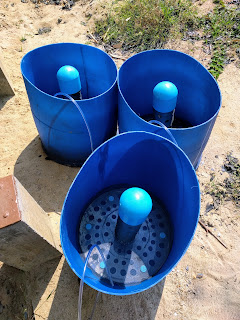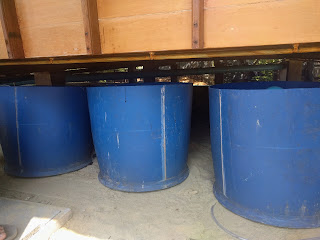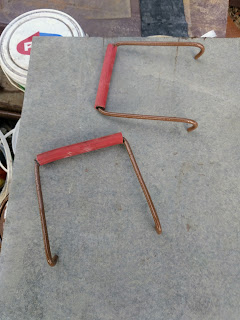We’ve been using the composting toilet in BaanRimNaam since we moved in late in December last year, and I like it a lot. Call me weird (many of my friends have), but I really like understanding and implementing the full path of our food from growing to cooking to eating to … well processing it after it comes out. As one of my coworkers, Thep, put it, “hey, everyone wants to know where the food originally comes from on the way in, why is it so weird that you’d want to know where it is going to end up on the way out.” (I suspect he was only being a little sarcastic here.)
But anyway, we only built one repository tank to get started and make sure everything is working. We based it on the composting toilet design by Bob Crosby of Biorealis and it has been filling up ever since. Interestingly, it was mostly full by the end of January, but seemed to grow and shrink since then. Presumably, the ingredients in the plastic drum have been composting, and composting results in quite a bit of shrinkage. (These ingredients are mostly sawdust from the construction of the house, but mixed in are small amounts of human waste, kitchen scraps, and coffee grinds.)
As a side note, we experimented with worms, but the worms didn’t seem to like it in there. I suspect this might be because the composting had already heated up and the worms can’t handle that kind of heat. I’ll need to try buying a composting thermometer and see.
Around mid March, the shrinkage seems to have slowed down, and I figured it was time to swap out the drums. So we built three more:
They store quite nicely out-of-the-way under the house:
The one change we made is we found a rounder end cap to the PVC pipe in the middle so that deposits are less likely to get stuck on top. (Do to placement, this never happens to human wastes, but kitchen scraps that get thrown in sometimes do.) The design of the insides are meant to allow air to reach deep inside the tank and keep the composting materials as aerobic as possible.
We also drilled small holes in the sides of the tank and built these handles out of scrap rebar to help lift the filled tanks (which can be somewhat heavy) in order to move them to somewhere out of the way.
These handles can be hooked in and used only when needed and then removed.
Carrying the full drums around isn’t anywhere near as disgusting as you might imagine. You simply throw a couple of scoops of sawdust into the toilet to cover the top of everything with a nice thick layer of nice clean sawdust and then roll the tank out from under the house. At this point, there is no discernible smell, and for all intents and purposes, it looks like you are carrying a plastic drum of sawdust.
So the interesting data point here is that while we needed to cut down the 200L drums to fit them under the house, the first one still lasted about 3 months before it seemed full enough to need to change out. And changing it out was nowhere near as disgusting as I was expecting.
So with 3 more drums, the full drum will simply sit in an out-of-the-way corner of our land and finish slow composting and age until all of the bacteria inside are dead. At that point, I will need to empty it to re-use the drum, but I can either throw the now nearly 1 year aged humanure into a larger compost bin and let it age some more, or start using it.
If the compost heats up to the normal temperatures of hot composting, most of the pathogens die in a matter of days. I figure there is no need to take any chances though. With a bit of space set aside, we can leave it there for a year or longer. If you look around, you can see references to certain pathogens like Ascari eggs lasting up to 6 months in pits if conditions are good for them, so it is prudent to wait.
Even then, I will likely still be cautious and only use the humanure compost at the base of trees and non-edible plants. But for those of you that think “ick, you are going to reprocess human wastes and keep them on your land”, it is worth reminding ourselves that the outdoors is a complete system practically designed for processing these materials. Given how many dogs, cats, squirrels, fish, rats, and whatever other creatures defecate all over our land, I’m not sure why properly composted and aged humanure should be considered the largest threat to health. Heck, people pay for cow manure to put on their plants.
I’ll be interested to see how this composting toilet humanure turns out in a year or so.


